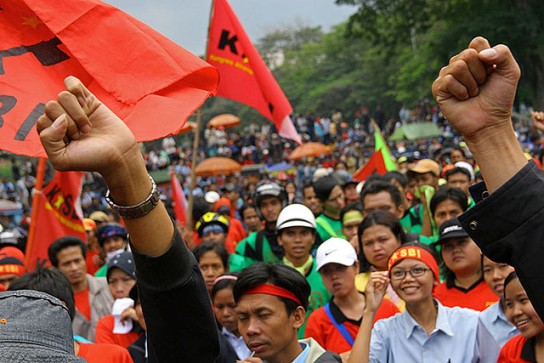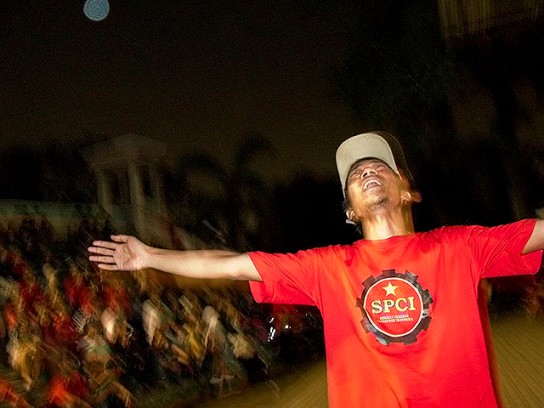Benny Hari Juliawan
A worker from French-owned supermarket chain at a May Day protest, 2008.Henri Ismail/Poros Photo |
When the authoritarian New Order regime collapsed in 1998, many people expected that organised labour would be in a good position to benefit. Successive post-Suharto governments changed labour laws in ways that expanded workers’ rights, made it easier to form trade unions, and granted greater freedom of speech and freedom of association. At the same time, state institutions have also been democratised and reorganised in a way that allows wider participation for workers. For example, the place for labour representatives in tripartite institutions from the district to the national levels is no longer reserved for the New Order’s tame union SPSI and is instead open to competition for all unions. In some regions, unions are members of government task forces that ensure the observation of labour laws. Democratisation of the political system also opened the way for workers and unions to form labour parties or to influence elections and ensure that pro-labour politicians get elected.
Most observers now agree, however, that the working population in general, and organised labour in particular, have failed to take advantage of the new avenues for participation. Many new trade unions have been formed (in total there are 90 national federations as compared to just one before 1998), and their membership has expanded to more than 3.4 million (July 2010 data). However, the generally low organisational capacity of unions, coupled with high unemployment and chronic labour surplus effectively erode their bargaining power vis-à-vis businesses and the state. Moreover, although trade unions have grown in numbers and membership, they have also shown a strong tendency to become embroiled in infighting, with the sector marked more by fragmentation and division than effective cooperation and joint campaigns.
Organised labour has had a particularly difficult time ensuring effective representation within state institutions. Trade unions in the revamped tripartite institutions still struggle to make a meaningful contribution to the betterment of workers’ welfare. Conflicts among unions represented in the tripartite bodies undermine their bargaining power, and they are often cunningly outmanoeuvred by government officials and employers. Organised labour has also had little impact in elections. In the three general elections since 1998, political parties with labour connections failed to win a single seat in the national parliament. Looking at all these failures, it is hard to paint a rosy picture of post-New Order labour politics.
Street protests
But is the gloom the complete picture of labour politics in Indonesia today? Look elsewhere and you will find workers taking to the street in the form of marches, strikes, and demonstrations or what they call aksi (actions). Indeed, the whole post-1998 era has been characterised by a stunning proliferation of street protests by a bewildering array of groups of people: from NGOs and trade unions, Islamic militants and community groups, to organisations of enthusiasts and hobbyists.
On almost any day in any major city, you will find not just one but several groups taking to the streets. The decriminalisation of public protests and a changing attitude towards dissent in general have allowed them to use the aksi method to challenge the authorities, intimidate rival groups or simply campaign for a cause. What significance should we attach to these movements?
As far as labour groups are concerned, the strategy of street protests is fundamentally different from the more established ways of dealing with the state and business interests in that it thrives in the absence or in the non-functioning of official institutions of representation, such as political parties, parliaments and the tripartite bodies. Where they perceive institutions of political power to be unresponsive, labour groups provide alternative channels of political participation by their public claim-making and collective actions. Street politics force the reconfiguration of power relations in ways that bypass the careful negotiations and deal-making that take place inside official political institutions. Just when democracy in Indonesia is taking shape and many people are most concerned with its institutions and procedures, labour groups are developing a tradition of popular challenges by way of conflicts, confrontation and potentially dangerous disputes.
In Tangerang city and district – one of Indonesia’s major industrial zones, on the western outskirts of Jakarta – the police recorded 2759 work stoppages between 1999 and 2004; in Medan city there were 188 strikes between 2005 and 2008. The forms of protest in these cases varied from quiet sit-ins within the walls of factories to noisy marches through the streets and lengthy occupations of government buildings. Innovations occur along the way as protesting workers try hard to send their messages to the authorities and to invite members of the public to participate in their world view.
At times, workers stage artistic performances in the middle of the road in the form of role-play with the characters dressed up in extravagant attire and colours, or they carry figurines with particular symbolism. Another strategy that is gaining popularity is occupations of government buildings, which can last for days, or even months. For example, the workers of the PT Baja Utama Wirasa Inti company in Medan occupied the parking space of the North Sumatra parliament building for 40 days from early December 2003 to mid-January 2004.
Street protests and especially long occupations of government buildings require a high level of coordination, militancy and complicated logistical arrangements, not to mention funds. Unions in Indonesia are not known for their organisational discipline in the traditional sense, with poor collection of dues and weak daily administration, but they have adapted to the demands and rigour of popular mobilisation and become skilful in organising large public gatherings. They have become, above all, vehicles of public protest.
Unions have become, above all, vehicles of public protest
Some elements in the trade union movement have even tried to embark on a controversial strategy that is known as ‘sweeping’. Used in the original English, this word refers to the act of picketing a factory and threatening the management with violence if they do not let their workers out to join the protesters. Not all unions agree with this strategy because it is often portrayed negatively in the media for its violence, whereas most unions want to be associated with the so-called aksi damai or peaceful protests.
The significance of protests
Labour groups may not have the clout that political parties or businesses have in the process of government policy making, but there is much about them that warrants closer observation. Having been deprived of a collective identity for decades, workers now assert their existence by congregating in large numbers, then disrupting the traffic or occupying buildings and landmarks. Such actions force the authorities to deal with them as a group and to recognise their collective power. They also succeed in persuading the general public to pay attention to the hardships that they endure. This street strategy constitutes a display of political power from an otherwise marginalised group in society, showing what they are capable of doing as human agents reshaping their own destiny.
 |
Workers try to reclaim public space through their protest actions.Henri Ismail/Poros Photo |
Street actions also help to reconstitute the street as a legitimate locus of populist power. Under the long years of Suharto’s authoritarian rule, the revolutionary street of Sukarno’s populist regime was turned into a space of discipline and fear. Along with protests by other groups in society, labour strikes and protests have helped to turn the space of the street into a site of political spectacle again.
This strategy has also helped to unravel one of the most enduring developmentalist alliances of the past. A feature of the New Order was the stable relationship between political and business elites that produced economic growth and the expansion of an apolitical middle class. In the post-1998 era, continual protests and popular mobilisation against the authorities instead contribute to a climate of a perpetual potential of ‘ungovernability’. The authorities fear they are always on the cusp of delegitimation.
Sustained protests unsettle power holders, pitting sections of the elite against one another and forcing them to take a stand on populist issues. A case in point is the annual tripartite process of minimum wage settlement which often brings local government officials, who have a stake in building popular support – including among workers – into conflict with business groups desperate to keep wages low.
In particular, when an industrial region is approaching elections, the incumbent regional head who seeks re-election is keen to court workers’ popular support and therefore prone to their pressure. Little wonder that representatives of business have increasingly accused government officials of sacrificing market rationality for populism by giving in to workers’ demands for substantial increases in minimum wages. For example, in November 2007 the local branch of the employers’ association (APINDO) filed a lawsuit in the state administrative court against the decision of the Tangerang mayor to increase significantly the regional minimum wages a year before the mayoral election. Thus, although the formal organisation of labour such as unions might be weak, workers can still exercise considerable pressure on issues directly affecting their lives.
The street is where we now should locate labour political power. In the midst of aggressive economic liberalisation and the authoritarian legacy of labour disorganisation, the street provides a space for the labouring population of post-authoritarian Indonesia to be both seen and heard.
Benny Hari Juliawan (benny.juliawan@usd.ac.id) is a lecturer in the Graduate School of Culture and Religion, Sanata Dharma University, Yogyakarta.
